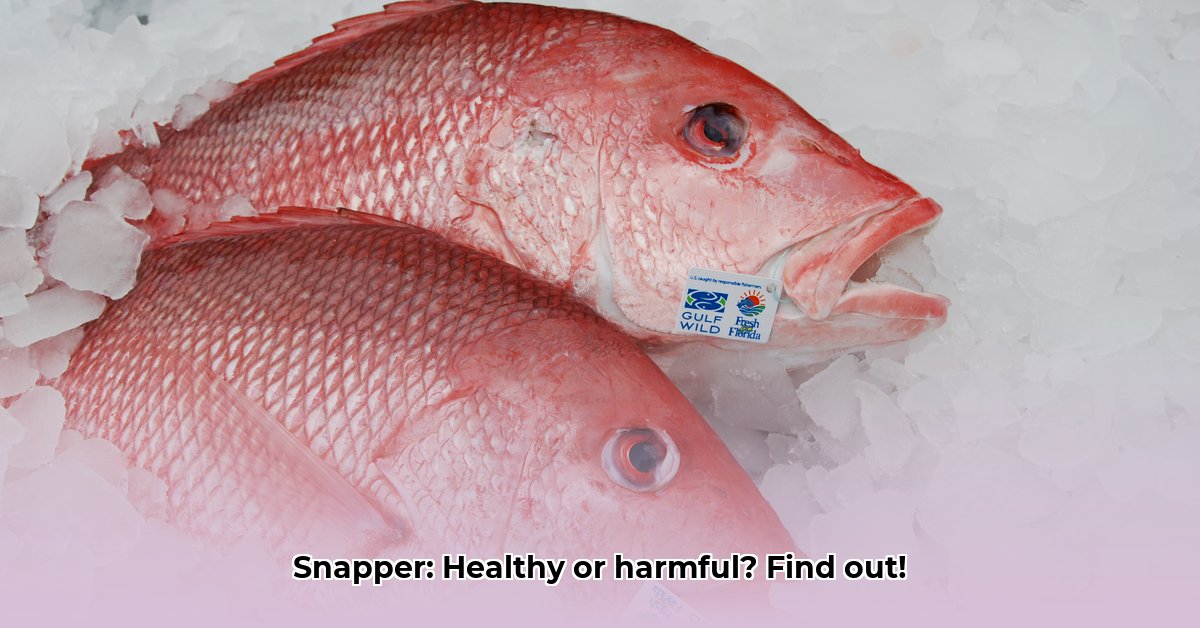Love snapper? So do many others, but is it truly healthy and is it okay to keep eating it? This guide cuts through the confusion, focusing on both red snapper and snapper in general. We will explore the nutritional benefits, and also examine the sustainability. Turns out, not all snapper is created equal. We’ll reveal how to choose the good stuff, including expert tips for safe eating and making sure your choices protect our oceans. For more on red snapper specifically, check out this helpful guide: Red Snapper Guide. Get ready to make informed decisions about this delicious fish!
Is Snapper Healthy to Eat? Understanding Nutritional Benefits and Sustainability Concerns
Is snapper a healthy and sustainable choice for your dinner plate? Let’s dive into the details! It’s a question many seafood lovers consider, balancing the tempting taste with concerns about personal health and the environment.
Nutritional Benefits: Exploring the Health Perks of Snapper Consumption
Snapper is a nutritional source. It’s packed with high-quality protein, essential for building and repairing your body. This lean protein is digestible and contributes to a healthy, balanced diet. Beyond protein, snapper offers omega-3 fatty acids, those heart-healthy fats known for their brain-boosting properties. It also contains essential vitamins, including vitamin D, important for bone health, and vitamin B12, vital for nerve function and red blood cell production. Finally, it provides minerals like selenium, an antioxidant protecting your cells from damage. The amounts of these nutrients vary depending on the fish’s species, size, and origin. Snapper is also a good source of Vitamin B6 and potassium.
Mercury Levels: A Consideration for Safe Snapper Consumption
While generally lower in mercury than some other fish, snapper’s mercury content requires awareness. Mercury is a heavy metal accumulating in the body, and excessive consumption poses health risks, especially for pregnant women, nursing mothers, and young children. Larger, older snapper typically contain higher levels. The geographic location also influences mercury concentration; certain areas have higher levels naturally. Eating snapper in moderation is crucial. The FDA provides guidelines on safe fish consumption levels.
For example, the Environmental Defense Fund (EDF) rates different types of snapper. Options like lane snapper and vermilion snapper are often listed as best choices due to lower mercury levels, while others should be eaten less frequently.
Sustainability: Balancing Supply and Demand for Snapper
The sustainability of snapper fishing is a story. One challenge is overfishing. In many areas, snapper populations struggle to recover due to demand. Certain fishing methods, such as trawling, damage ocean floor habitats, disturbing marine ecosystems and affecting other species. This non-target catch, called “bycatch,” includes other fish, marine mammals, and sea turtles. Sustainable fishing is vital for our oceans’ long-term health.
Navigating the Seafood Market: A Guide to Choosing Responsibly
How do you ensure your snapper consumption benefits you and the planet? Becoming a savvy seafood consumer is simpler than you think.
Tips for responsible snapper purchasing:
- Look for certifications: The Marine Stewardship Council (MSC) certification indicates sustainable fishing methods, accounting for the fish population’s long-term health. Look for the MSC blue label on the packaging. The Aquaculture Stewardship Council (ASC) is relevant for farmed snapper.
- Know your source: Opt for domestically caught snapper whenever possible, meaning shorter transportation and transparent fishing practices. Ask your fishmonger about the origin.
- Read labels carefully: Mislabeling of seafood is a problem. What you see isn’t always what’s inside. Be vigilant and check the source information.
- Moderate your consumption: Even with sustainably sourced snapper, moderation is key to balance its nutritional benefits with mercury intake. Aim for 1-3 servings a week, based on the type of snapper and guidelines from organizations like the EPA.
- Support conscious choices: Choose restaurants and retailers committed to sustainability. By supporting businesses prioritizing responsible sourcing, you’re encouraging industry-wide improvements.
- Consider farmed vs. wild-caught: Farmed snapper can be a sustainable option if the aquaculture practices are responsible. Look for certifications and information about water quality and environmental impact. Wild-caught snapper requires verification of sustainable fishing practices.
Sustainability Risks and Mitigation Strategies: A Detailed Look
| Risk Factor | Likelihood | Impact | Mitigation Strategies |
|---|---|---|---|
| Overfishing | High | Very High | Stricter quotas, sustainable fishing techniques (e.g., hook and line), marine protected areas, promoting responsible aquaculture |
| Mercury Contamination | Medium | Medium | Moderate consumption, choosing smaller fish from low-mercury areas, consulting resources like the EDF Seafood Selector |
| Mislabeling | High | High | Improved traceability systems, stricter regulations, consumer education, DNA testing to verify species |
| Habitat Destruction | Medium | High | Implementing more selective fishing gear, habitat restoration projects, reducing bottom trawling |
| Climate Change Impacts | Very High | Very High | Reducing greenhouse gas emissions, adapting fisheries management to changing conditions, supporting research on climate-resilient fish populations |
| Bycatch | Medium | High | Using modified fishing gear to reduce bycatch, implementing bycatch reduction programs, promoting the use of circle hooks, avoiding sensitive areas |
Wrapping Up: Prioritizing a Delicious and Sustainable Future
The answer to “Is snapper healthy to eat?” is yes, with caveats. Enjoy this fish in moderation and make decisions about its origin to protect your health and our oceans. Sustainable seafood choices safeguard marine biodiversity. By being informed, you enable a future where we can savor delicious seafood while safeguarding our marine resources. Keep exploring, keep questioning, and keep making sustainable choices.
How to Identify Sustainably Sourced Snapper
Key Takeaways:
- Snapper is nutritious, rich in protein and omega-3 fatty acids. Sustainability concerns exist.
- Mercury levels are generally low, but moderation is advised, especially for vulnerable populations.
- Mislabeling is a problem. Informed choices protect health and the environment.
- How to identify sustainably sourced snapper requires label and sourcing awareness.
Nutritional Powerhouse: Investigating the Benefits and Risks of Snapper
Snapper, with its texture and flavor, is a seafood choice. It’s packed with protein, essential for tissues. It also boasts omega-3 fatty acids, beneficial for heart health. Vitamins D and B12, along with selenium, add to its profile. While generally low, mercury levels vary depending on origin and age. Pregnant women, nursing mothers, and young children should exercise caution and consume snapper in moderation. Check local advisories for regional variations in mercury levels.
The Sustainability Struggle: Addressing Overfishing and Mislabeling Issues
Snapper faces threats. Overfishing has depleted some populations, and unsustainable fishing practices harm ocean ecosystems. Bycatch, the capture of non-target species, is an issue. Many fishing methods damage habitats, leading to environmental problems. This makes how to identify sustainably sourced snapper a consumer skill.
Consumers often buy fish falsely labeled as snapper, when it’s actually a cheaper, less desirable species. This harms consumer health (you might not be getting the nutritional benefits you expect) and the sustainability of snapper fisheries (the demand for “snapper” may not accurately reflect the real demand).
Decoding the Labels: Your Guide to Responsible Consumption
So, how to identify sustainably sourced snapper? It starts with label reading.
- Look for Certifications: The Marine Stewardship Council (MSC) certification is your friend. It indicates that the snapper comes from a fishery managed to sustainable standards. The Aquaculture Stewardship Council (ASC) certification is relevant for farmed snapper and offers guarantees.
- Check the Scientific Name: Different types of snapper have different scientific names. For Red Snapper, look for Lutjanus campechanus. For others, consult reliable seafood guides. If the label lacks this or specifies a different species, be skeptical.
- Ask Questions: Ask your fishmonger or restaurant about the source. Where was it caught? How did they get it? Transparency helps.
- Buy Local When Possible: Supporting local fisheries often means lower transportation emissions and a better chance of knowing the source.
- Practice Moderation: Even with sustainably sourced snapper, remember mercury content. Limit servings, particularly for vulnerable groups. Check local advisories for guidelines.
Navigating the Nuances: Regional Differences and Fishing Methods
Snapper populations and environmental impact vary by location. Understanding this is key to truly understanding how to identify sustainably sourced snapper. Gulf of Mexico stocks, for instance, are different from those off Florida, requiring region-specific advice. Different fishing methods also have ecological footprints. Hook-and-line fishing tends to be more environmentally friendly compared to bottom trawling. Researching region-specific best practices for snapper consumption is recommended.
- Why Glass Boxes for Lunch Are Trending for Meal Prep - December 17, 2025
- Bento Box Glass Offers Practical, Eco-Friendly Meal Storage - December 16, 2025
- The Best Bento Box Price For Your Perfect Packed Lunch - December 15, 2025










